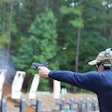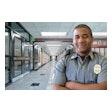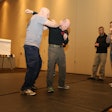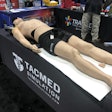It seems many manufacturers are determined to cover all of a user’s needs in one tool. However, if your overloaded pocket tool is roughly the size of a Snap-On mechanic’s box, the odds are it will be too cumbersome to carry all the time. What is needed is a knife and tool you can easily carry that still provides you with all the basics.
To meet this need, Gerber Legendary Blades has developed the Kinderer Rescue Knife. Designer Rick Kinderer is a firefighter, rescue diver, EMT, and knife designer. He brought his first-hand public safety knowledge to the table to build this user-friendly rescue knife.
The Kinderer Rescue Knife is designed from the ground up as a rescue knife, not a knife that as an afterthought can be used as a rescue tool. In the size of an average clip-it knife, it packs a serrated blade, a window-breaking tip, a seat belt/harness cutter, and an oxygen tank wrench. As an added bonus, the knife comes with an auxiliary tool that can accommodate a number of screwdriver bits that fit into the included carry pouch.
The first feature that sets the Gerber Kinderer apart from other “rescue” knives is its window-breaking tip. Discreetly placed on the lanyard loop, it doesn’t add any length to the knife. It is also out of the way so you won’t poke yourself in the hand during use.
The handle also features an oxygen tank wrench. Yes, I know oxygen tanks have a handle on them. But what if the handle falls off? How do you open the valve then? Sounds like a replacement would be in order, hence the built-in wrench.
Another feature ideal for rescue is the knife‘s folding seatbelt cutter. I know the knife blade is designed to be safe next to the human body, but what if you are in cramped quarters? The diminutive belt cutter is the answer; it is short and unobtrusive. It’s also ideal for extracting yourself from a rappelling or parachute harness should the releases fail.
Believe it or not, Gerber’s Kinderer knife comes with even more tools. These tools are separate from the knife and are essentially a quarter-inch drive unit with multiple bits. From the factory you get flat tip and Philips head screwdrivers as well as three hex head bits to fit most screws you encounter on duty.
As if all these features weren’t enough, Gerber also included a sheath that is belt- or MOLLE compatible. The sheath closes with Velcro and a snap. Even the case is over-constructed, to ensure the knife will stay put.
Although designed as a rescue tool, the Kinderer Rescue Knife is also a solid knife on its own merits.
What sets the Gerber Kinderer apart from the rest of the folding knives out there is its lock mechanism. Giving the knife a quick first glance, it appears to have a standard liner lock. But it also has a cool external lock release.
The lock release is a sliding thumb stud that keeps your fingers out of the frame/blade area of the knife to help prevent the blade from cutting across the back of your fingers when closing the knife. This external lock release is secure and is simple enough to operate in the darkest, wettest conditions. Simply pull it to the rear so the liner lock releases and close the blade. It’s simple enough that the most mechanically challenged among us can operate the knife.
The Gerber Kinderer’s blade is as distinctive as its locking system. The serrated blade looks like any other, except that the portion of the blade in front of the serrations is blunted and the tip is totally rounded. This gives the knife a sharp blade that is safe when cutting close to the body. If you can cut someone with the tip of the Kinderer, you’ve really worked at it. I couldn’t cut my leg with it and I actually tried to push the blade into my thigh. (By the way, this is not a suggested test).
The serrated portion of the Kinderer’s blade is as sharp as the tip is dull. The blade makes short work of clothing, harnesses, package banding, etc. I don’t advise testing the blade’s sharpness against your thigh; I guarantee you’ll need suturing.
Anchoring the knife are its frame and handle. The handle is textured red nylon-filled fiberglass with stainless liners. It has a good, solid feel in the hand. All of the knife’s controls are large and checkered to ensure a solid grip no matter how wet the knife or your hand gets. Even the clip of this knife is “super sized” to ensure it will survive hard use and keep the knife where it belongs.
Overall, the Gerber Kinderer Rescue Knife is a heckuva tool. It is designed by an operator to meet the needs of his fellow public safety operators. This is a no frills all business tool and was truly built with your needs in mind.
Scott Smith is a disabled veteran who served as an active duty Army MP and in the U.S. Air Force Reserve and Air National Guard as a security policeman. He is a contributing editor to Police Magazine.
Gerber Legendary Blades--Kinderer Rescue Knife
It seems many manufacturers are determined to cover all of a user’s needs in one tool. However, if your overloaded pocket tool is roughly the size of a Snap-On mechanic’s box, the odds are it will be too cumbersome to carry all the time. What is needed is a knife and tool you can easily carry that still provides you with all the basics.

















